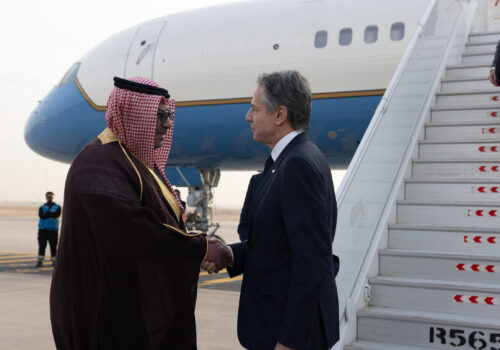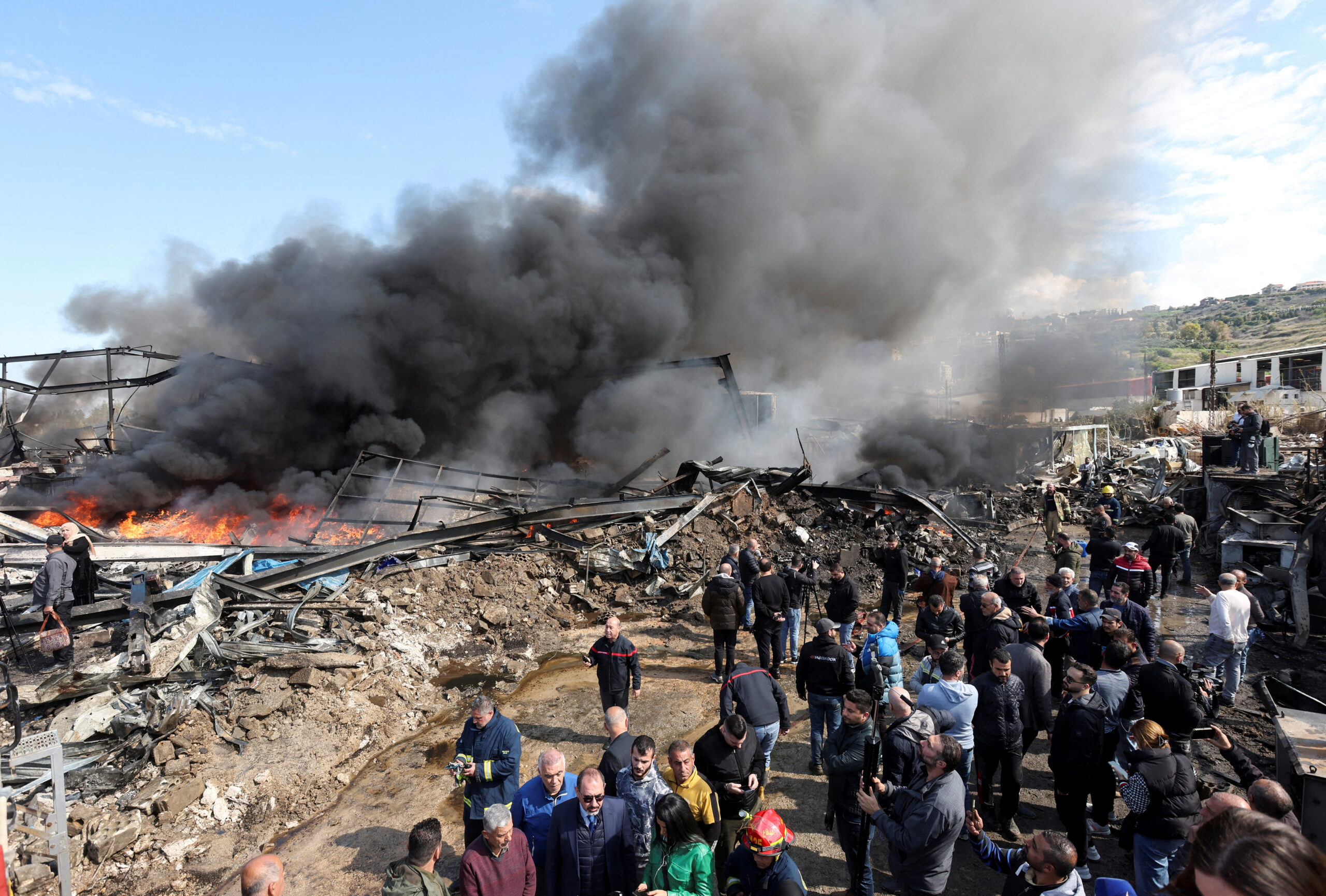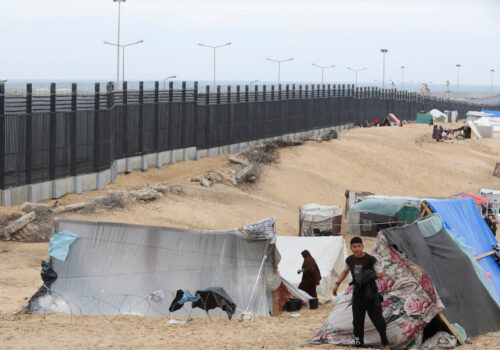As fighting along the Lebanon-Israel border escalates, diplomats scramble to head off a war
As international diplomats inch closer to securing a ceasefire and hostage release deal between Israel and Hamas, efforts to bring an end to the fighting along the Lebanon-Israel border have yet to bear fruit even as the clashes continue to escalate.
On February 26, Israel staged its deepest air raid into Lebanon in years, hitting targets just west of Baalbek, some 62 miles (100 kilometers) north of the border with Israel. They reportedly included two buildings—one affiliated with a Hezbollah civilian institution—and a convoy of trucks. Israel said it had hit part of Hezbollah’s air-defense network. The raid came hours after Hezbollah shot down an Israeli reconnaissance drone over south Lebanon. In response to the Baalbek air raid, Hezbollah fired some sixty rockets at an Israeli military base in the central Golan Heights and, on February 27, launched a rocket attack on the Mount Meron air-control center.
Fighting has steadily escalated since the beginning of the year, with attacks and counterattacks creeping deeper into Lebanon and Israel with each passing week. Judging from comments made by Israeli Defense Minister Yoav Gallant, a ceasefire arrangement in the Gaza Strip may have no impact on the fighting along the Lebanon-Israel border. During a four-day lull in Gaza in November 2023, both Hezbollah and the Israeli military also ceased fighting. But on February 25, Gallant said that even if a ceasefire takes effect in Gaza, “We will continue the fire [against Hezbollah], and we will do so independently from [Gaza] until we achieve our goals… to withdraw Hezbollah to where it should be, either by a diplomatic agreement or we will do it by force.”
But diplomacy is moving slowly. Hezbollah has repeatedly said it refuses to participate in any negotiations until Israel ends its war in Gaza. Israel says it prefers a diplomatic solution but is prepared to launch a major operation against Hezbollah if diplomacy fails or takes too long. In a February 22 letter to the United Nations Security Council (UNSC), Israeli Foreign Minister Israel Katz warned, “We will not be patient much longer for a diplomatic solution in the north.”
The Israeli government faces mounting pressure from some eighty thousand residents of northern Israel who have been evacuated to areas further south to escape the violence along the border. Mindful of the Hamas assault on October 7, 2023, that left some 1,200 Israelis dead, the residents of the north are collectively refusing to return to their homes until Hezbollah has been pushed back from the border. However, achieving that goal is no simple matter. Hezbollah is not a regular army deployed in various barracks that can be moved from one location to another. Hezbollah fighters live with their families and work in the villages and towns of the southern Lebanese border district.
International diplomatic efforts appear to focus on exploring generally practical, and potentially achievable, ideas. At the heart of these deliberations is finding ways to strengthen the commitment of both parties to UNSC Resolution 1701, which helped end the 2006 war between Israel and Hezbollah. Among the clauses in the resolution was for the area between the Litani River and the Blue Line—the UN name for the boundary corresponding to Lebanon’s southern border—to be free of all weapons except for those of the Lebanese state and the UN Interim Force in Lebanon (UNIFIL) peacekeeping mission, which operates in the southern border region.
In practice, however, Hezbollah and Israel have paid little heed to the resolution’s demands. Israel breached Lebanese airspace on a nearly daily basis, using manned aircraft and unmanned aerial vehicles (UAVs) for reconnaissance missions or to launch attacks into Syria. Since 2006, Hezbollah has maintained a military presence in the southern border district, which was all but invisible until three or four years ago. Around 2020, Hezbollah began emerging into the sunlight, establishing dozens of border observation posts nominally manned by personnel from Green Without Borders, an environmental nongovernmental organization affiliated with the group, as well as discreet military posts tucked into wooded valleys. Less discretely, Hezbollah constructed six 100-meter (328-foot) firing ranges, where local militants practiced shooting with an array of weapons from rifles to rocket-propelled grenades. The latest firing range, a bulldozed 100-meter (328-foot) strip, lies in a valley less than 5 kilometers (3 miles) from UNIFIL headquarters in the coastal village of Naqoura.
France and the United States have offered separate proposals to end the fighting. However, Hezbollah has remained dismissive of any negotiations before the war in Gaza ends, and the Lebanese government has yet to respond formally. The French offer, according to diplomats, would see a de-escalation in fighting over several days, an end to Israeli overflights, a pullback of Hezbollah fighters to a certain depth from the border, and the deployment of some fifteen thousand Lebanese Armed Forces (LAF) troops in accordance with UNSCR 1701. The French proposal also mulls the possibility of establishing a monitoring group to adjudicate any complaints by either side—similar to the five-nation body that operated between 1996 and 2000 during the latter years of Israel’s occupation of south Lebanon. The US proposal is similar, but unfolds in three phases: first, Hezbollah pulling back by between 8–10 kilometers (5–6 miles) from the border; second, an increased presence of LAF troops south of the Litani River; third, a return of displaced Lebanese and Israeli civilians to their homes. The deal would include a commitment to reach agreements on delineating the Lebanon-Israel border, a possible cessation of Israeli overflights, and potential financial incentives for Lebanon.
If reports on details of the US proposal are correct, in its current configuration, the offer is unlikely to fly with Hezbollah and, therefore, the Lebanese government, which is not in a position to override the powerful group’s views. For Hezbollah, after months of fighting, deaths of dozens of cadres—including senior field commanders—and destruction of property in south Lebanon border communities, a withdrawal of the party’s fighting force from the border in exchange for a vague promise to discuss the path of the international boundary would be a non-starter.
SIGN UP FOR THE THIS WEEK IN THE MIDEAST NEWSLETTER
For a sustainable cessation of hostilities to succeed, the Israeli government and Hezbollah will require “wins” they can sell to their respective domestic audiences to justify the bloodshed, destruction, and population displacement of Lebanese and Israeli civilians. That means both sides will need to give concessions. Neither side seeks a full-scale war, and after five months of fighting, Israel and Hezbollah are probably ready to be led to an off-ramp that leads to a cessation of hostilities. Sources in south Lebanon close to Hezbollah tell me that the organization is concerned at the growing vocal unhappiness of Lebanese Shias whose homes and livelihoods have been destroyed by Israeli shelling and air strikes. The fighting, they say, has lasted far longer than was originally expected.
So what concessions can be placed on the negotiating table for both sides to mull over? Israeli Prime Minister Benjamin Netanyahu has repeatedly said that his government’s goal is to achieve “total victory” against Hamas and to return Israeli hostages to their families. But on the northern front, Israel’s priority is returning the evacuees safely to their homes. Therefore, it is looking for a tactical solution to achieve that goal, rather than necessarily effecting a decisive strategic win against Hezbollah. The group’s massive stockpile of rockets, precision-guided missiles, UAVs, and tens of thousands of fighters is a long-term problem for another day.
International diplomats tell me that the Israeli military is seeking an end to the threat posed to Israeli border communities by Hezbollah’s relatively short-range weapons systems, such as mortars and anti-tank missiles, as well as the ability of the group’s elite Radwan Brigade to cross the frontier en masse in an October 7-style assault. Ending those threats would require a weapons-free zone of a few kilometers from the border (the distance depending on factors such as topography), even if Hezbollah fighters are still living and working in border communities. In such a scenario, Hezbollah would agree to a cessation of hostilities with Israel and agree not to rebuild its Green Without Borders observation posts along the Blue Line. Similarly, it would agree to abandon the six firing ranges, along with the small military bases that have emerged since 2020, many of which have been destroyed since October 2023 in Israeli airstrikes. With enhanced international support and funding, the LAF would deploy in much greater strength along the Blue Line. These accommodations would allow the Israeli government to tell the eighty thousand evacuees that Hezbollah is no longer a threat along the border and that they can return to their homes and resume everyday life.
If Hezbollah accepted some or all of those conditions, it could sell the deal to its supporters on the basis that the LAF, as per its national duty and responsibilities, is to man the “frontline” against the Israeli “enemy.” At the same time, Hezbollah would assume the role of Lebanon’s “strategic reserve,” with its rocket and missile arsenals and army of trained fighters—a powerful deterrence factor. Such an argument would fall neatly within Hezbollah’s somewhat strained explanation to justify why it needs to keep its weapons—the so-called “golden triangle” formulation in which the “army,” the “resistance” (Hezbollah), and the “people” combined are the key elements of Lebanon’s defense strategy against Israel.
For Hezbollah to even contemplate accepting these conditions, Israel would also need to offer concessions. Simpler concessions could include Israel committing to ending its troop presence in the northern end of Ghajar, which lies on the Lebanese side of the Blue Line. Israeli troops have been present in northern Ghajar since the end of the 2006 war with Hezbollah in contravention of UNSCR 1701. Another simple concession is for Israel to knock down a wall it constructed four years ago on the Lebanese side of the Blue Line in a World War II-era railway tunnel that runs through the Ras Naqoura headland on the Mediterranean coast. In addition, Israel could quickly reach an agreement on thirteen locations where Lebanon and Israel disagree on the path of the border (this is part of the US proposal). Unwritten solutions regarding seven of those disputed locations were reached a few years ago and, given sufficient mutual goodwill, the remaining disputed areas could be resolved quickly through minor land swaps.
Among the more difficult concessions would be Israel agreeing to cease overflights in Lebanese airspace. Israel will likely oppose such a compromise, but there is wiggle room for negotiations. Israel could commit to cease using Lebanese airspace to launch attacks against targets in Syria. Or it could agree to end manned overflights in Lebanese skies, while continuing with UAVs and other intelligence, surveillance, and reconnaissance (ISR) assets. Perception will play a role in reaching agreements. For example, Israeli jets are often visible from their contrails and audible. UAVs, on the other hand, usually fly too high to be seen or heard. If Israel were to agree to end manned overflights, the Lebanese public would see no Israeli aircraft in the skies above, creating a perception that Israel is no longer breaching Lebanese airspace.
Another thorny concession is an Israeli troop withdrawal from Shebaa Farms, an unpopulated mountainside running along Lebanon’s southeast border that the UN considers occupied Syrian territory but Beirut claims as Lebanese land. Syria has never officially declared in writing that the Shebaa Farms belong to Lebanon, rendering the sovereignty of the mountain ambiguous. If Israel agreed to pull out of Shebaa Farms, UNIFIL could deploy there in its place until Lebanon and Syria finally decide to whom the land belongs. A troop withdrawal from the Shebaa Farms would be the jewel in the crown for Hezbollah and a bitter pill for Israel to swallow. But Shebaa Farms, first and foremost, is a potential bargaining chip for Israel, and dangling the possibility of withdrawing from the area could help maximize concessions from Hezbollah. It’s all in the negotiations.
Still, even if both parties agree to make an equitable number of mutual concessions that lead to a prolonged cessation of hostilities, there remains the question of verifying that the deal is not breached by one or both parties. Trying to agree on a credible and unbiased verification mechanism that both parties would support could present a new set of headaches.
Gaza is key to the Lebanon-Israel front. If a temporary ceasefire is reached in the Gaza Strip but Israel continues attacking Hezbollah, the Lebanon-Israel border will remain on fire, with all the attendant risks of it spiraling into a broader conflagration. If, however, Hezbollah and Israel observe the Gaza ceasefire, that could allow a window for accelerated diplomatic efforts to reach a long-term cessation of hostilities along the Lebanon-Israel border. The chances of calming the Lebanon-Israel border will be that much greater if a temporary ceasefire in Gaza evolves into a permanent ceasefire.
After the trauma of October 7, 2023, and five months of fighting Hezbollah, Netanyahu’s hardline government may be in no mood to offer any concessions to its Lebanese adversary. However, without mutual concessions, it is unlikely that a diplomatic agreement will be reached—and if diplomacy fails, the only alternative is war.
Nicholas Blanford is a nonresident senior fellow with the Atlantic Council’s Middle East Programs.
Further reading
Thu, Feb 22, 2024
The future of Saudi-Israeli relations is a balancing act between Palestinian and regional interests
MENASource By R. Clarke Cooper
Any credible movement to formalize bilateral relations between Riyadh and Jerusalem cannot ignore what the Saudis have consistently stated about the two-state solution.
Wed, Feb 21, 2024
A steady escalation along the Lebanon-Israel border—and no end in sight
MENASource By Nicholas Blanford
If the Gaza war drags on for much longer and clashes continue to persist along the Lebanon-Israel border, the pressure on the Israeli government to launch some form of offensive into south Lebanon is going to be hard to resist.
Sun, Feb 18, 2024
Regardless of Sisi’s decision on Palestinian refugees in Rafah, he will not emerge as a winner
MENASource By Shahira Amin
Now that Israel has clarified its intent to undertake operations in Rafah, after evacuating the nearly 1.4 million displaced Palestinians who have sought a safe haven in the Gaza Strip’s southern city, it may only be a matter of time before the Egyptian’s president’s true intentions are revealed.
Image: Smoke rises from a site believed to have been hit by an Israeli strike, in southern Lebanon, in this screen grab taken from a video, February 27, 2024. REUTERS TV via REUTERS/File Photo



